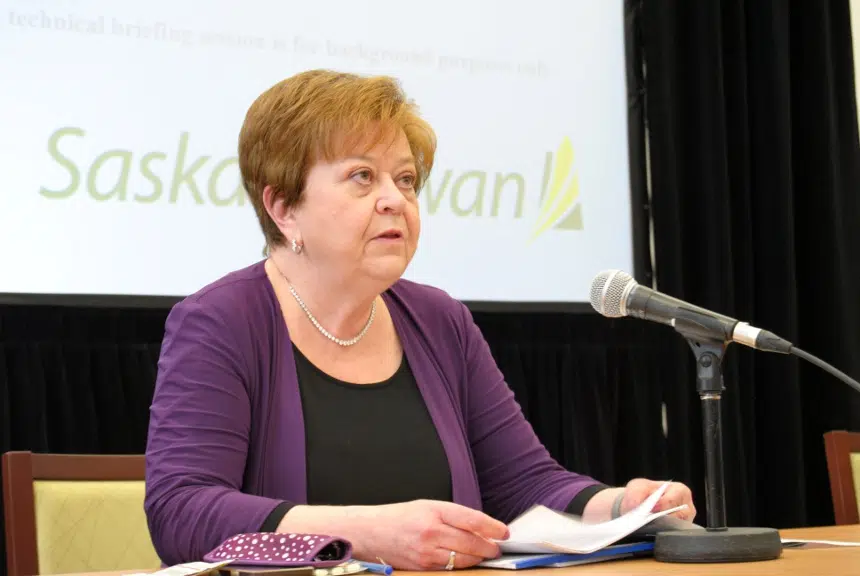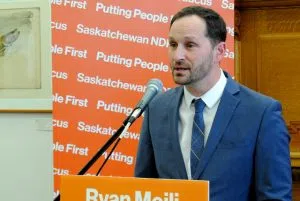COVID-19 was at the top of people’s minds on Wednesday as the provincial government released pared-down numbers for the coming fiscal year.
The government only released the spending estimates for the year, not the revenues.
Finance Minister Donna Harpauer said the changes in revenues due to COVID-19 and the market fluctuations were impossible to predict.
Last year at budget time, Harpauer said she was most concerned about a crop failure wiping out the government’s thin surplus.
“I didn’t ever anticipate this and I don’t think anyone did. I kind of watched the markets, and I can’t use that language in this room,” said Harpauer.
Harpauer said she expects to end up with a deficit.
“I recognize there will be a deficit and let’s just see how this unfolds. And, as we’ve proven in the past when we had a $1.3-billion hole, at that point in time where there’s some stability again we will evaluate where we’re at and how we can best come with a plan of what we need to do to get out of it,” said Harpauer.
There’s some insecurity in the spending as well. Harpauer said right now, the only extra cost to the province around COVID-19 is in the testing, but that could change.
The province has a $1.3-billion cash reserve Harpauer said it can call on as a contingency to pay for any large expenses that come up, whether related to COVID-19 or not.
Despite a possible drop in revenue, Harpauer doesn’t seem interested in bringing in any new taxes, saying that every tax affects the economy.
“At this time I don’t think it is a wise decision to try to backfill this catastrophic situation we’re in with raising taxes and shocking the economy even more,” said Harpauer.
For his part, the leader of the Opposition NDP, Ryan Meili, didn’t think the province should be talking about the budget at all. He said the government should be focusing on its response to COVID-19 and what the province needs.
When it comes to what Meili thinks the province needs, and the spending document the government released Wednesday, Meili said they’re on completely different planets.
“What’s going to be needed at this time is a major injection, both into the health system and into the economy in general, into people’s pockets to make sure they can make ends meet. None of that is in the document, which is not a surprise,” said Meili.
He says the spending was finalized in February and doesn’t take into account what’s happened in the first few weeks of March.
“It never made sense to introduce a budget (and) it makes even less sense to introduce half of a budget with no revenue description,” Meili said. “This is a document that — while there are things that we will continue to look at and try to understand what they mean — is in so many ways divorced from today’s reality.”
Meili thinks the government should be taking further action to flatten the curve, including limiting gatherings to fewer than 50 people, give clear instructions to businesses and organizations, put in measures to increase the health-care system’s capacity, and create a financial aid package for people in the province affected by the virus.
The government plans to spend $14.15 billion in the budget, an increase of 3.1 per cent over last year.
Health
The estimates call for $5.77 billion to go to the Ministry of Health, an increase of $211 million over the previous year.
The Saskatchewan Health Authority is to receive $3.74 billion, an increase of $140.6 million from 2019.
The area of mental health and addictions is to receive $434.5 million, up $12 million from 2019. Nearly $5.8 million of that is to support addictions initiatives and $6.2 million is to fund mental health services.
The government is funding crystal meth in-patient treatment services in Estevan, but not the safe injection site in Saskatoon.
The government is spending $20 million in an attempt to reduce wait times. It estimates about 3,700 more surgeries can be completed with the additional funding.
The Saskatchewan Cancer Agency is to get $196.4 million, an increase of $18.4 million from the year before.
There is $8 million earmarked for 36 acute care beds at Saskatoon’s Regina University Hospital and $2.3 million for 100 long-term beds in Regina and Emerald Park.
There is $142 million in health-care capital spending planned, including the recently announced Victoria Hospital in Prince Albert.
A 72-bed long-term seniors care facility in Meadow Lake ($15.7 million) and diagnostic imaging ($4 million) also are funded in the budget. That latter number includes $2 million for a new CT scanner in Melfort.
The government also is supplying $400,000 more for a new manufacturing facility for the Vaccine and Infectious Diseases Organization, the Saskatoon-based organization that is working on finding a vaccine for COVID-19.
Education
The government is putting $2.57 billion into education, an increase of 3.5 per cent over the previous year.
That includes $1.94 billion in operating costs for the province’s 27 school divisions.
Seven new schools will be built and three schools will be renovated through a $130.4-million investment in education capital spending.
A new joint-use elementary school is being planned for Harbour Landing and a new joint-use consolidation is planned for Imperial, St. Peter and St. Michael schools.
St. Frances Elementary School will be built in Saskatoon, with the consolidation of Princess Alexandra, King George and Pleasant Hill elementary schools also in the works.
A new school also is to be built in Carrot River.
The Ministry of Advanced Education is to receive $739 million, an increase of $11.2 million over last year’s budget. The money will go to post-secondary institutions and to support students and graduates with programs such as the Graduate Retention Program.
Social Services
The $1.29 billion going to social services marks a four per cent increase over 2019.
A total of $613 million — an increase of $27.4 million from last year — is to fund enhanced programming and support for people with disabilities.
Increased funding of $10.9 million is for third-party service providers, with $6.8 million more going to those who work with people with intellectual disabilities and $2.5 million more earmarked for those working with at-risk kids and families.
There’s also an increase of $2.5 million for family supports and a hike of more than $2.1 million for new group homes in Regina and Saskatoon for youth with complex needs.
Housing
The government is introducing a new PST rebate for new home construction.
It’ll cover up to 42 per cent of the PST paid on a new house contract up to $350,000, excluding the land. The homes must have been purchased after March 31 of this year and before April 1, 2023.
The government is putting up $3.4 million to help launch the new Saskatchewan Housing Benefit, which previously was announced by the federal government. The plan, which is to begin April 1, is to help individuals or families who require rental support.
Other Expenses
The budget contains $648 million for the maintenance, repair and resurfacing of 1,000 kilometres of road this year.
The government is providing $166 million for municipal infrastructure projects and $213 million in targeted investments for Indigenous communities, businesses and organizations.
The Crown corporations are to receive $1.7 billion for infrastructure projects, including $845.7 million to SaskPower (for the Moose Jaw power station as well as other plans), $406.7 million to SaskEnergy (in part for natural gas projects) and $324.5 million for SaskTel (to pay in part for a 5G network).
There is $278 million set aside for municipal revenue-sharing, up $27 million from 2019.
The Saskatchewan Public Safety Agency is to receive more than $85 million, with a portion going to the Gang Violence Reduction Strategy. Community service organizations will get $14 million more in this budget than they did in 2019.
There also are tax measures included in the budget for pipeline development, irrigation expansion plans and agricultural technology.
As well, the government has set aside money to address the 14 contracts the government has open with its employees.
— With files from 980 CJME’s Lisa Schick












